Samsung Galaxy S 5 Review
by Anand Lal Shimpi & Joshua Ho on April 8, 2014 12:00 AM EST- Posted in
- Smartphones
- Samsung
- Mobile
- Galaxy S 5
CPU Performance
The Galaxy S 5 marks the second Snapdragon 801 based device we've reviewed at AnandTech, the first being HTC's M8. I've gone through the Snapdragon 801 in depth already, but we're basically dealing with a reasonable upgrade to Snapdragon 800 on an improved 28nm HPm process. The bulk of the improvements impact GPU and ISP performance, but the SoC is just better overall. GS5 owners are lucky as all versions of the device that use Qualcomm silicon feature the MSM8974AC v3 SKU, which includes four 2.5GHz Krait 400 cores and a 578MHz Adreno 330 GPU.
| Snapdragon 800/801 Breakdown | ||||||||||
| SoC Version | Model | Max CPU Frequency | Max GPU Frequency | ISP | eMMC | DSDA | Memory IF | |||
| MSM8974VV | v2 | S800 | 2.2GHz | 450MHz | 320MHz | 4.5 | N | 800MHz | ||
| MSM8974AA | v2 | S800 | 2.3GHz | 450MHz | 320MHz | 4.5 | N | 800MHz | ||
| MSM8974AB | v2 | S800 | 2.3GHz | 550MHz | 320MHz | 4.5 | N | 933MHz | ||
| MSM8974AA | v3 | S801 | 2.3GHz | 450MHz | 320MHz | 5.0 | Y | 800MHz | ||
| MSM8974AB | v3 | S801 | 2.3GHz | 578MHz | 465MHz | 5.0 | Y | 933MHz | ||
| MSM8974AC | v3 | S801 | 2.5GHz | 578MHz | 465MHz | 5.0 | Y | 933MHz | ||
Although Samsung was the first major OEM to be caught cheating in Android benchmarks, it appears to have completely abandoned the practice with the Galaxy S 5's shipping software. Not only was I unable to find any evidence of the old cheats, I couldn't find any evidence of HTC's new subtle cheating either. The Galaxy S 5 appears to be clean as far as I can tell. Kudos to Samsung on doing the right thing, and I hope all other OEMs take this as a sign to stop the silliness.
For our performance tests I turned to our usual suite of browser and native applications. If there's one obvious takeaway from our CPU tests it's that despite having faster silicon than HTC's M8, the GS5 isn't always faster. I believe this has more to do with thermals than anything else. HTC's metal chassis is able to do a better job of dissipating heat than the GS5's plastic chassis. I don't believe there's a substantial impact on user experience, but it's interesting to note how choice in materials can have a performance impact like this.
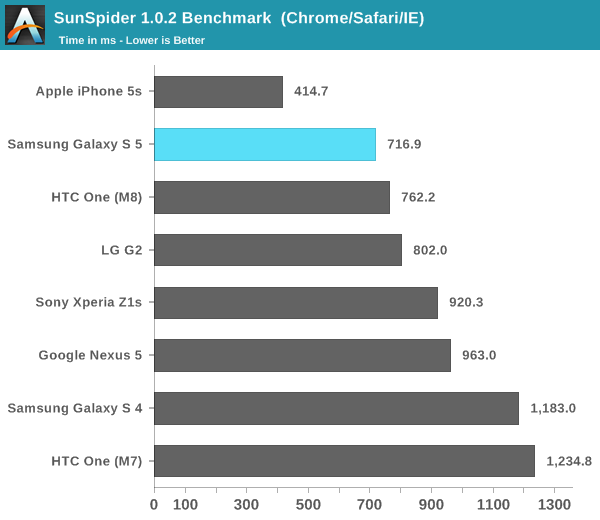
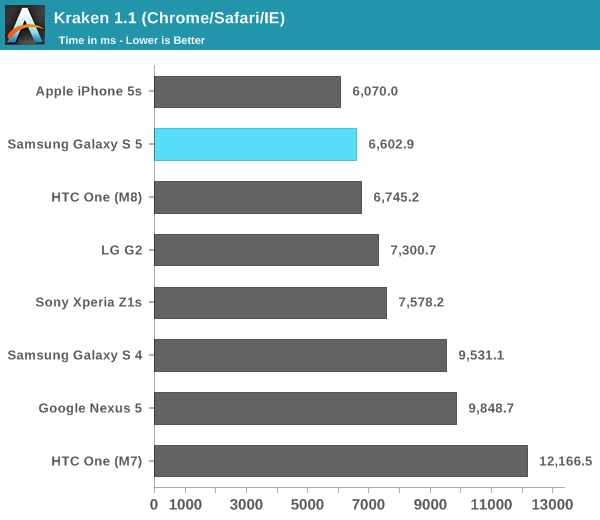
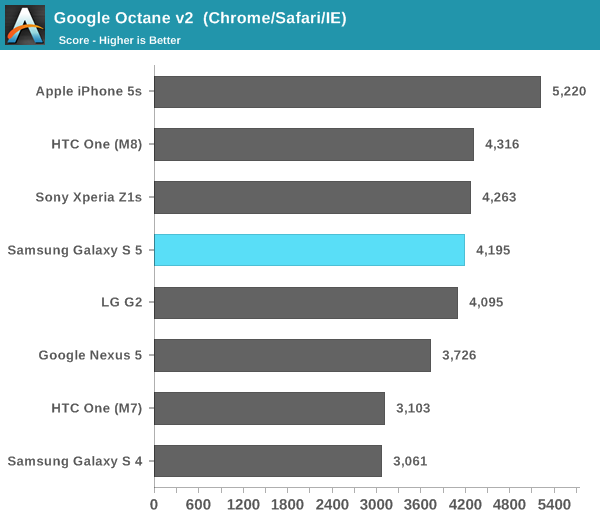
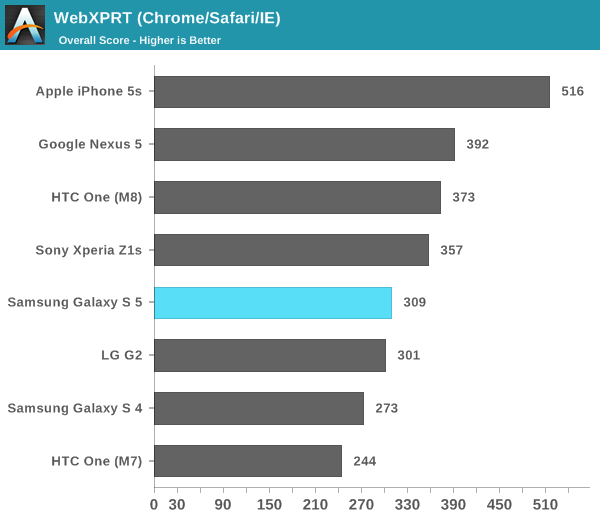
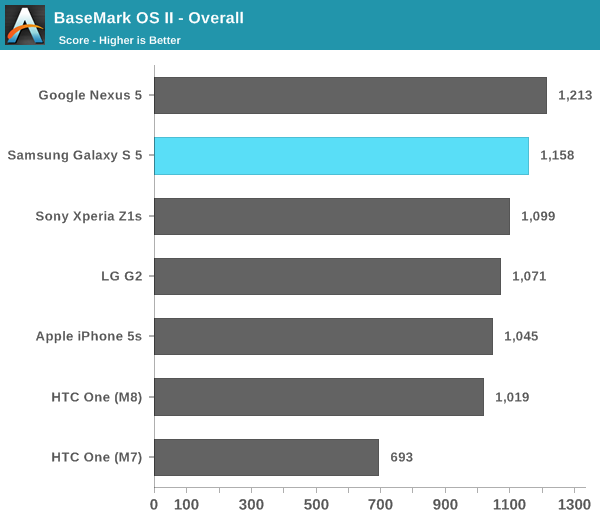
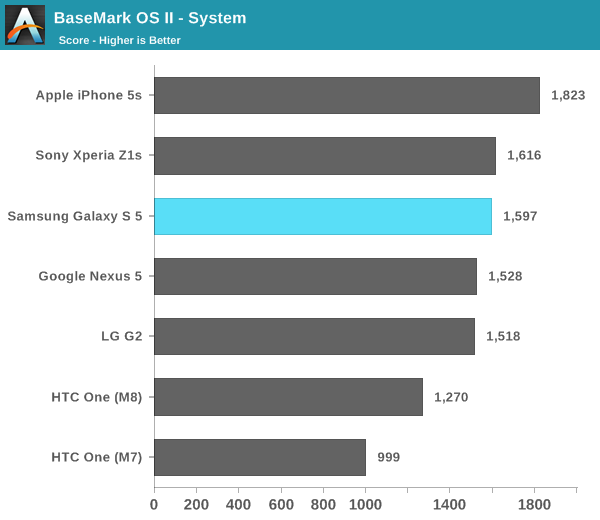
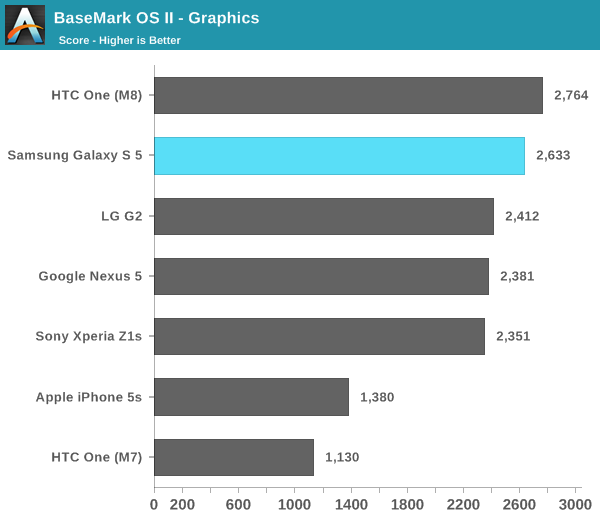

GPU Performance
GPU performance remains where we see the biggest benefit from Snapdragon 801 vs. 800, and since the GPU gains are almost entirely due to frequency scaling it's not too surprising that the M8 pulls ahead of the GS5 here in most cases.
There aren't any surprises here. The Adreno 330 in the Galaxy S 5 is more than capable of driving the device's 1080p display both in current and near term future 3D games.
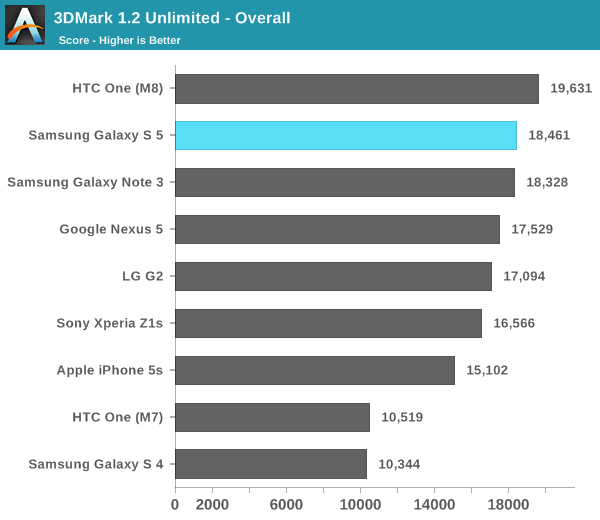
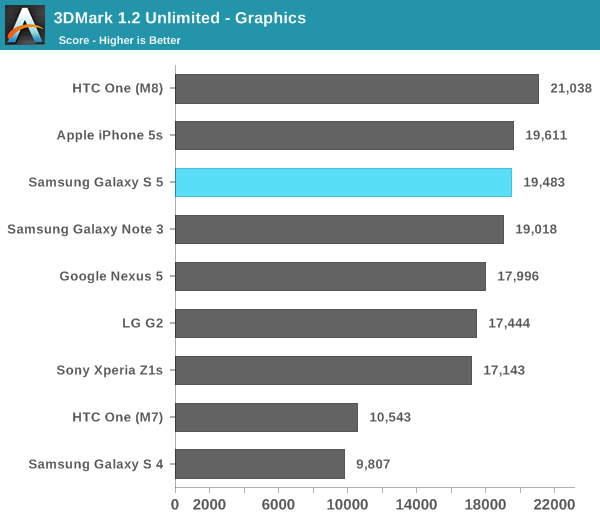
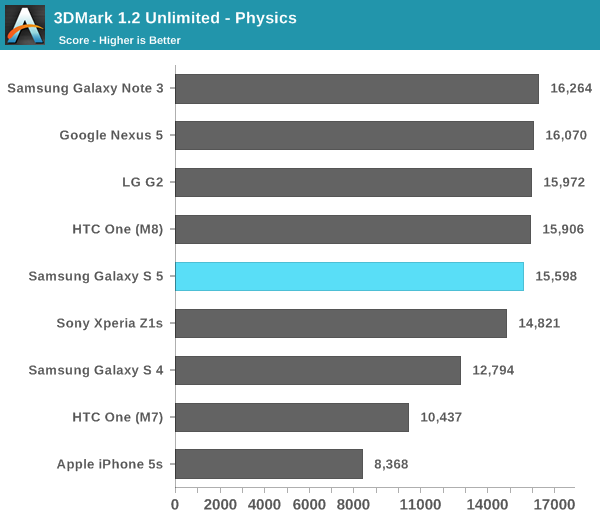
BaseMark X 1.1
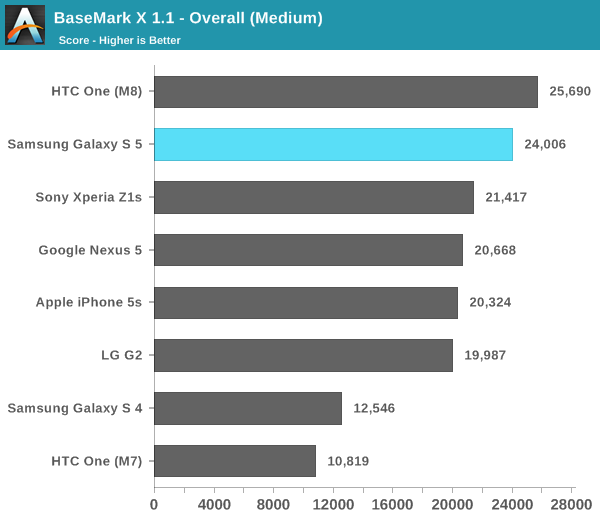

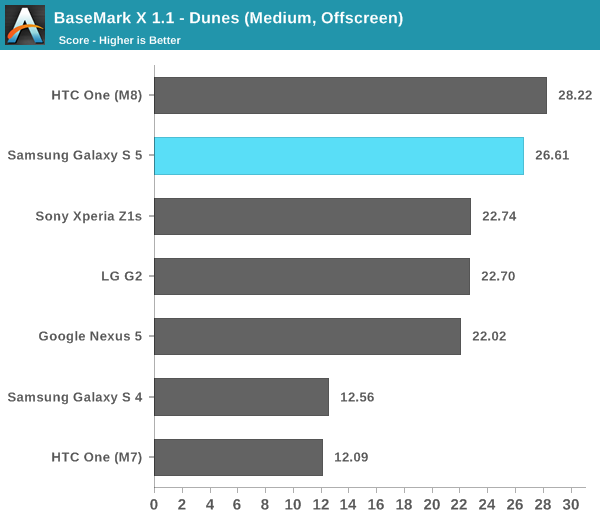
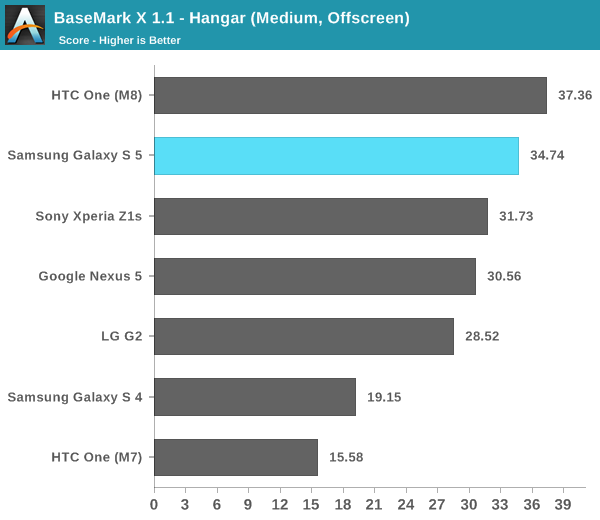

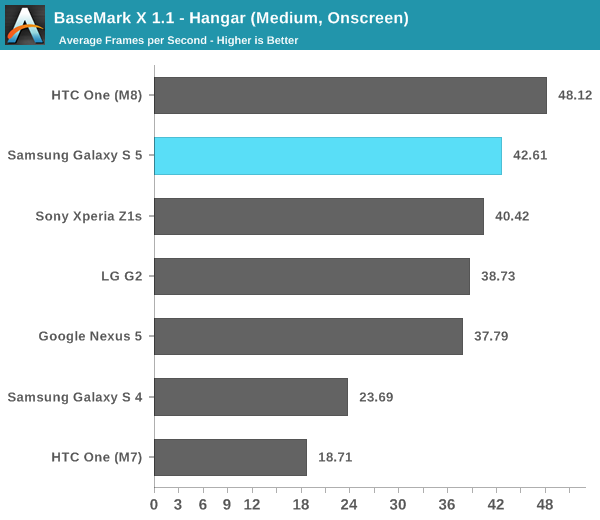
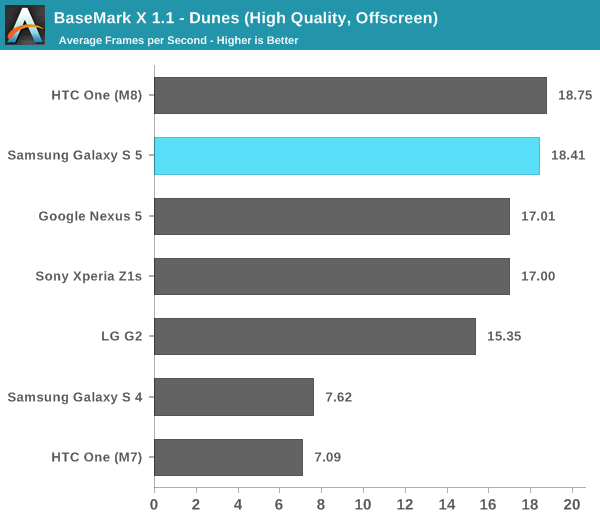
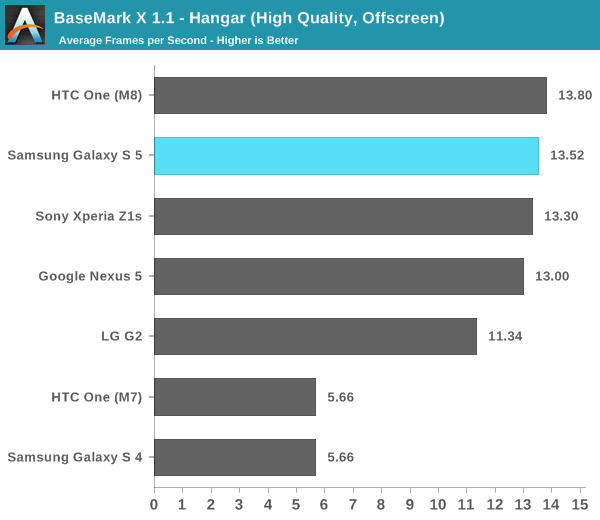
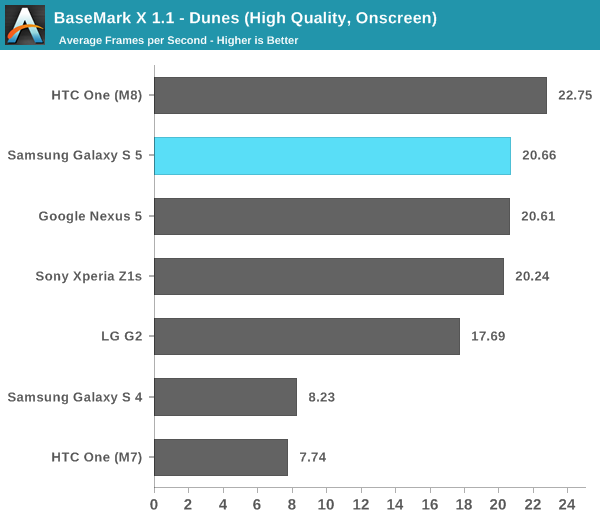
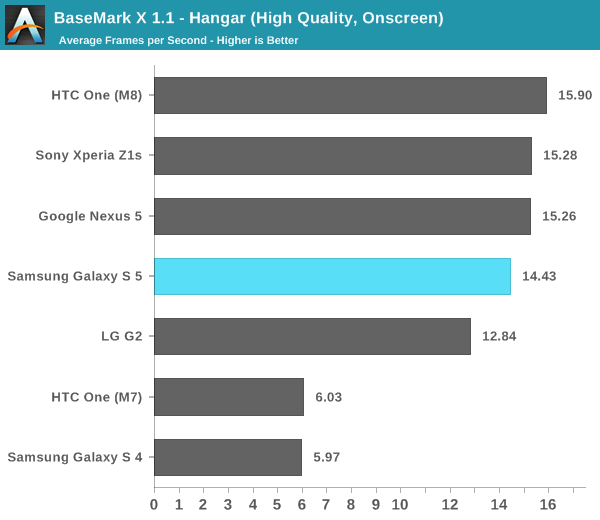
GFXBench 3.0
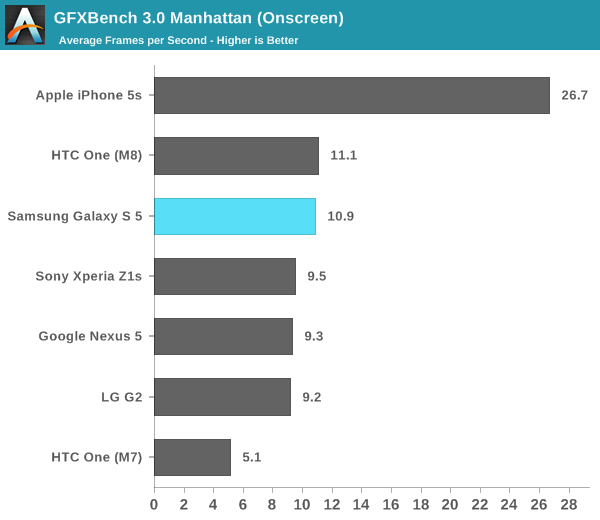
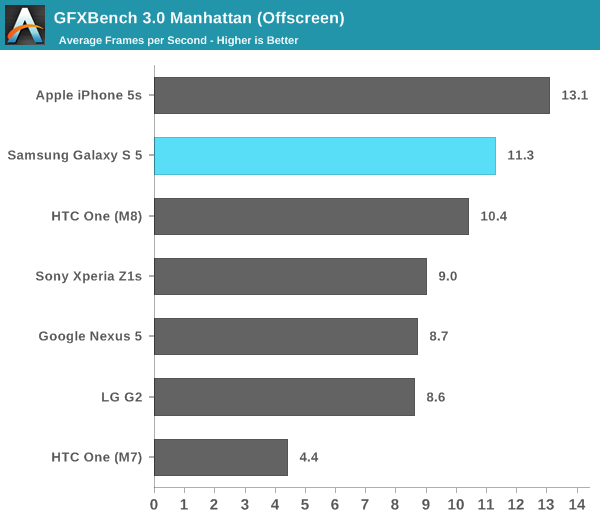
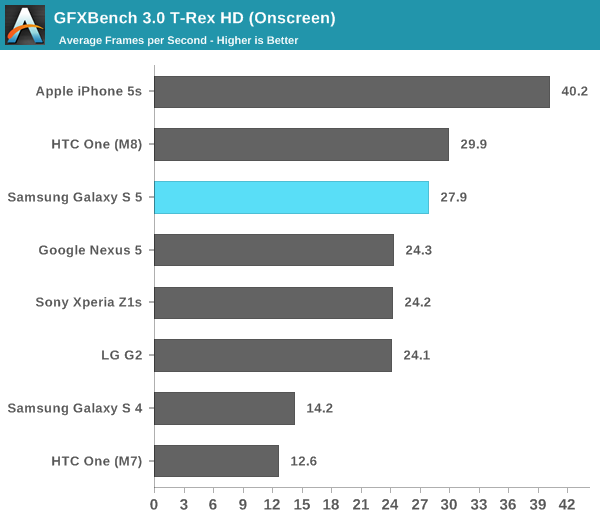
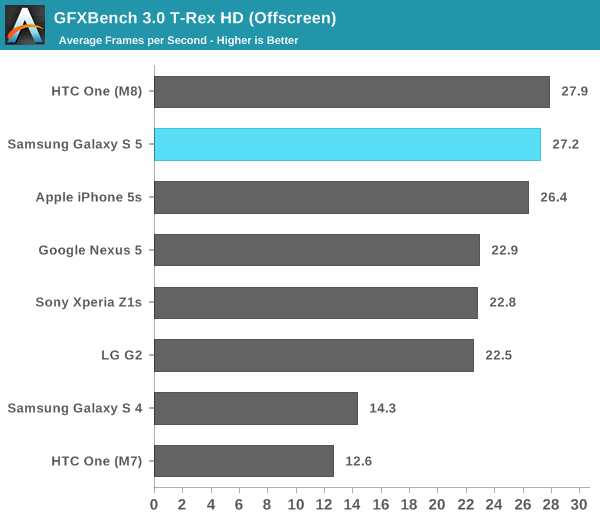

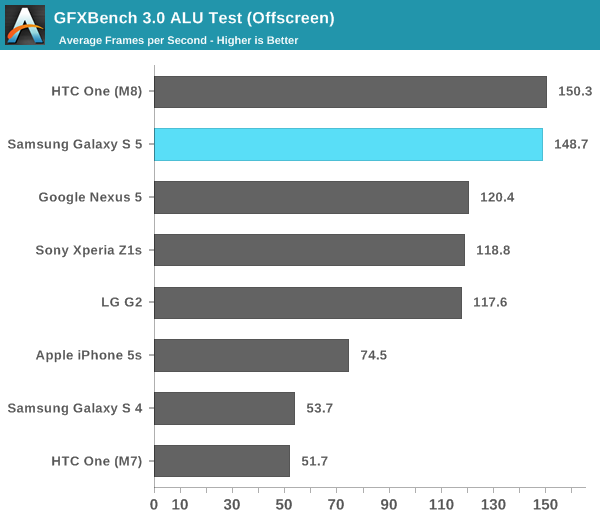


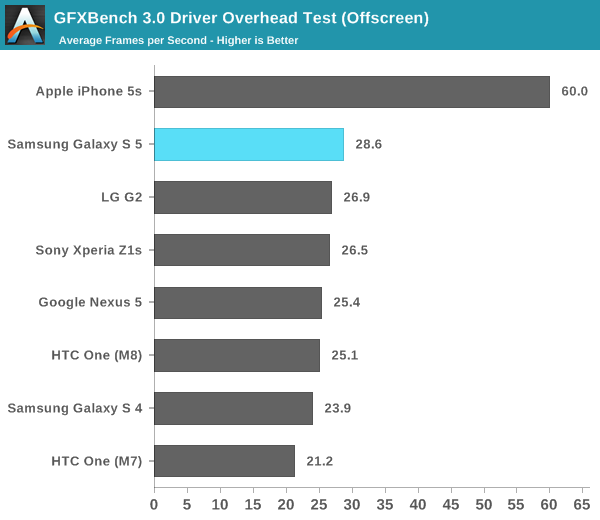
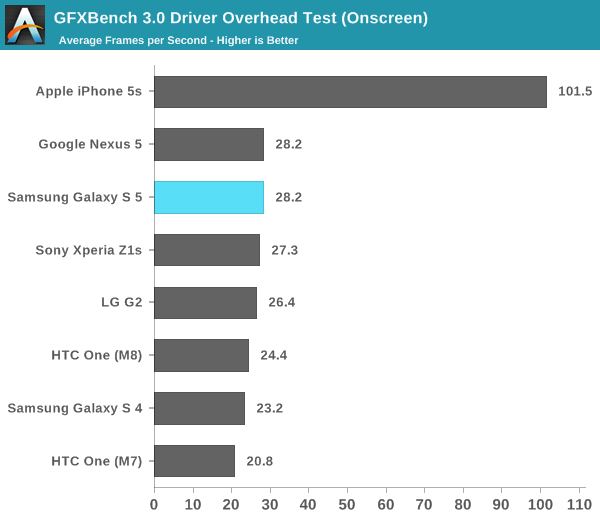
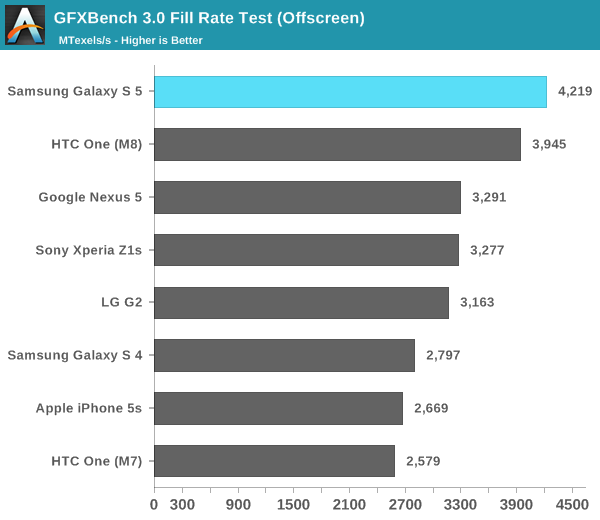
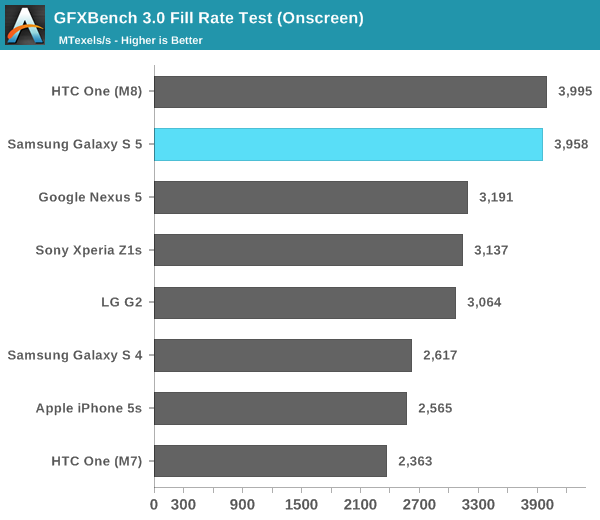
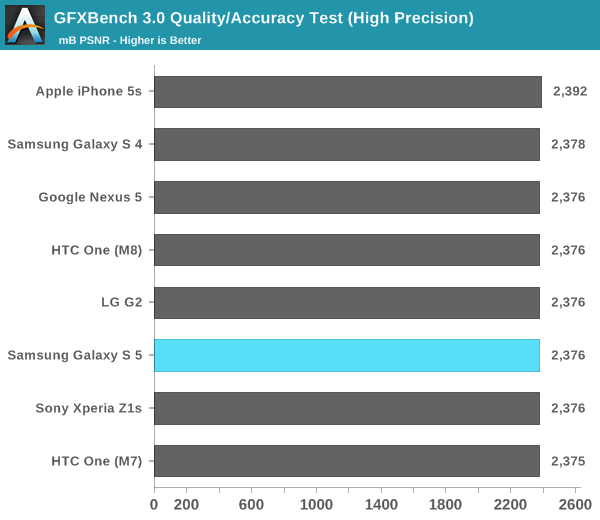
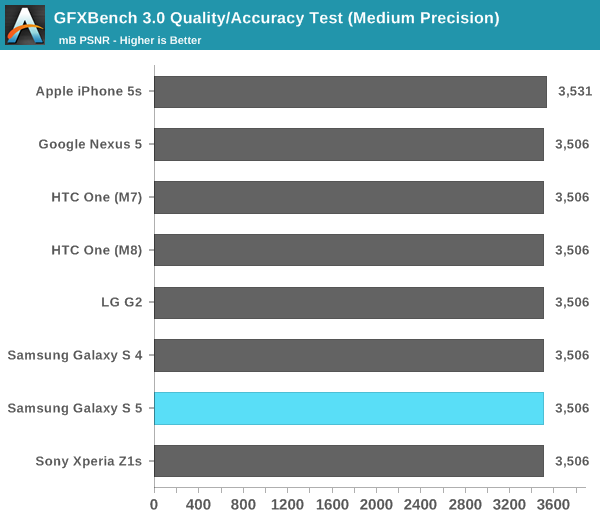
NAND Performance
The GS5 ships with 16GB or 32GB of NAND internally on an integrated eMMC device. Expansion is supported through a microSD card slot behind the removable back cover. Although the Snapdragon 801 inside supports eMMC 5.0, that alone doesn't guarantee a substantial increase in NAND performance. Keep in mind that most OEMs find multiple sources for their internal eMMC/NAND solutions, so what I'm testing here may only be representative of a portion of all GS5 devices.
Samsung sampled a 16GB GS5 review device. I put it through our usual random/sequential IO tests on a 100MB span of LBAs.
Random read performance is disappointing, it falls behind all modern devices we've tested. Random write performance is middle-of-the-road at best. It's unclear to me if this is a cost optimization or a lack of concern for NAND performance, but either way I'd rather see these metrics improve rather than regress.
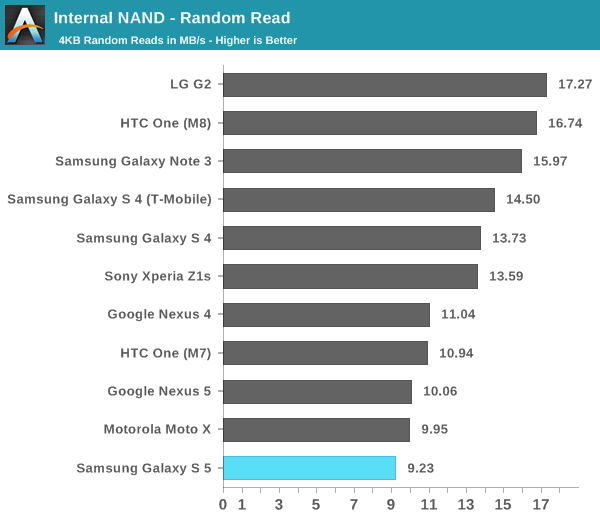
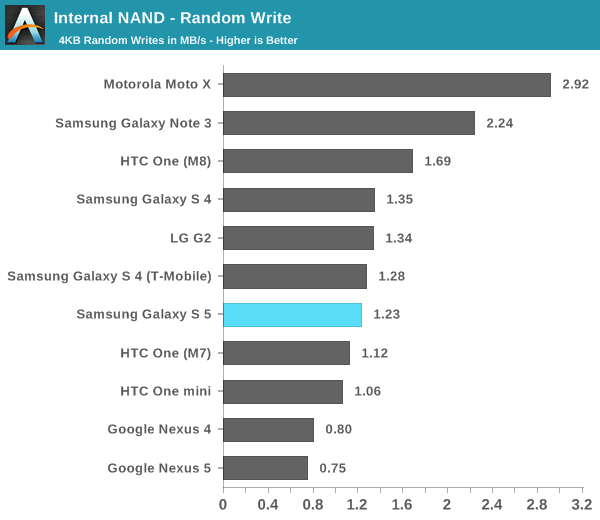
Sequential read/write performance both improve handsomely compared to the Galaxy S 4. I can see why Samsung would want to optimize for these two cases as they are quite common in regular usage, but random read/write performance can also significantly impact user experience.
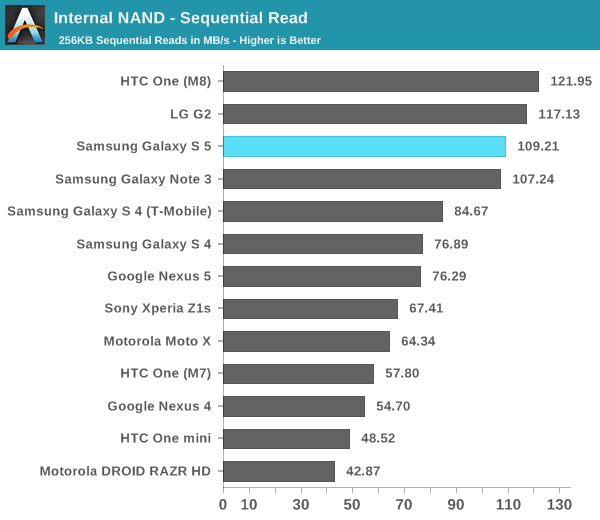
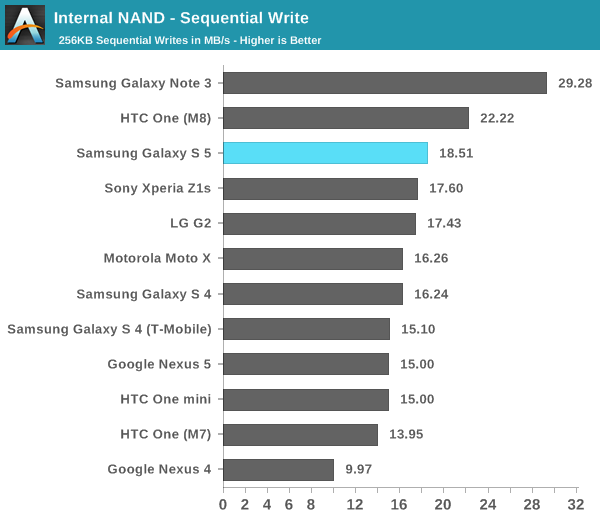










296 Comments
View All Comments
evilspoons - Tuesday, April 8, 2014 - link
The first few generations of modern smartphones were playing catch-up with the rest of the tech industry. They're now at the forefront - incremental gains is all you're going to see from now on.coburn_c - Tuesday, April 8, 2014 - link
Loses to the Lg G2 in battery life. Loses to the LG G2 in design. Loses to the LG G2 in life.hobochangba - Tuesday, April 8, 2014 - link
Although i predict it will monster the G2 in sales. Which, in this modern age, is all that's really important.coburn_c - Tuesday, April 8, 2014 - link
Shame too, the G2 is 200 dollars cheaper at T-mobile.marcolorenzo - Tuesday, April 8, 2014 - link
Really? Maybe I'm old fashioned but I was under the impression that the better device is what's important, at least for us consumers. If you work for Samsung or are a stock holder, than yes, their sales figures should definitely concern you. Otherwise if you think it's important than you're just another sheep.inighthawki - Tuesday, April 8, 2014 - link
I'll take a SAMOLED display over an LCD any day.pppp6071 - Tuesday, April 8, 2014 - link
If u want highly over saturated colors and no ability to read in sunlight and greenish tint and RGBG cheating.. yeah go for it. cant help. NEXUS 5 is having the best screen till date and it is using LCD and so is HTC ONE M8 and LG G2.Alexey291 - Tuesday, April 8, 2014 - link
Maybe you're right and its oversaturated (reading in direct sunlight is impossible on any of the current crop of backlit panels - sorry but that's just how life is) but using anything after the samoled screen looks bland, grey and frankly crap.But yeah that rgb spectrum is important or something. We should care or whatever.
And nexus 5 has a crap screen btw.
dylan522p - Tuesday, April 8, 2014 - link
"current crop of backlit panels - sorry but that's just how life is"No, M8 and iPhone have extremely good brightness and can be.
Alexey291 - Tuesday, April 8, 2014 - link
Its not like I haven't seen the last two iphones (5s and 5 - let alone 4s 4 and earlier, I haven't seen the m8 - nor do I care to its not going to sell anyway. Just like last year.). They were just as unreadable in the sun as my current S4. So lets not argue anecdotal evidence mkay?That said - S5 has a locked bootloader. Thus holds no interest for me. Plus its a rehash with slightly better internals. Just like every other "flagship" this year so far.
What a boring year in the mobile space. That is to say until apple's ip6 (and if that's a rehash - the whole year is a write off)